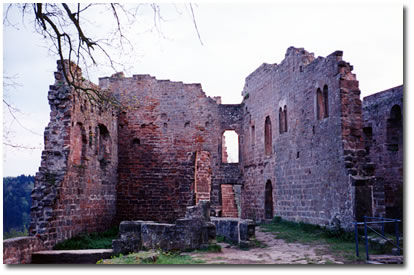|
|
|
|
|
|
 |
 |
|
|
| Hohenecken
Castle, Hohenecken, Germany |
|
|
|
 |
 |
 |
 |
 |
 |
 |
|
|
When reading
or thinking about castles in Germany,
especially those prevalent along the
Rhine River, one might refer to the
structures individually as a "schloss,"
meaning palace in German. But in the
German language, burg translates to
the word fortification.
Hohenecken Castle is known as Burg
Hohenecken in Germany.
With the discovery of a sarcophagus
in 1895, reported archaelogical evidence
says that the mountaintop on which
Burg Hohenecken was constructed was
possibly fortified during Roman times.
The final departure of the Romans
in 406 C.E., however, reportedly left
the vicinity of the future castle
unpopulated for many centuries.
Historical documents focusing on the
village of Hohenecken state that Frederick
I, who donned a red beard and was
dubbed "Barbarossa," began
to fortify the Palatinate soon after
being elected emperor, or "kaiser,"
in 1152. Frederick I began building
a castle at Lautern, or Kaiserslautern,
and other fortifications – of
which Burg Hohenecken was considered
the largest. Construction on Burg
Hohenecken is believed to have not
been finished until after 1210. In
the 1560s, the Hohenecken family reportedly
continued fortifying the castle.
Having survived the Thirty Years'
War from 1618-1648 unscathed and the
period of unrest thereafter, French
troops invading the area in 1688 in
pursuit of a "scorched Earth
policy" occupied the castle.
It wasn't long before the French filled
the burg with powder charges. The
castle soon exploded. Following its
destruction, Burg Hohenecken was never
restored.
[ Back
to Photographs • Next
Photograph ]
|
 |
 |
 |
|
|
 |
|
 |
|
|
|
|
|
|
|
|
 |
 |
|